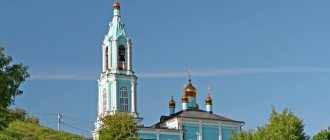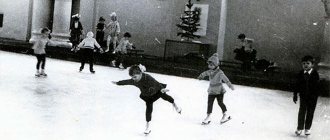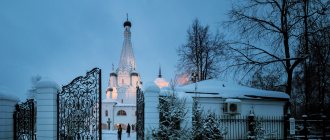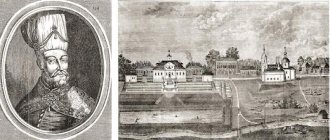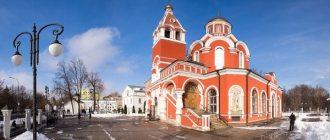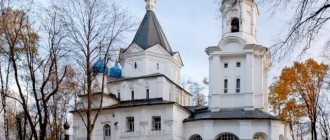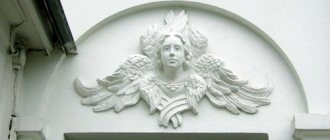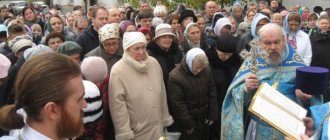Mir
Russia Moscow Church of the Dormition of the Blessed Virgin Mary on Uspensky Vrazhek (Moscow) Map is loading…
{"format":"leaflet","minzoom":false,"maxzoom":false,"limit":50,"offset":0,"link":"all","sort":[""], "order":[],"headers":"show","mainlabel":"","intro":"","outro":"","searchlabel":"\u2026 \u0441\u043b\u0435\ u0434\u0443\u044e\u0449\u0438\u0435 \u0440\u0435\u0437\u0443\u043b\u044c\u0442\u0430\u0442\u044b","default":"","import-annotation":false,"width ":"auto","height":"350px","centre":{"text":"","title":"""link":"""lat":55.75849720000000075970092439092695713043212890625,"lon": 37.60992780000000124118741950951516628265380859375,"icon":""},"title":"","label":"","icon":"","lines":[],"polygons":[],"circles":[ ],"rectangles":[],"copycoords":false,"static":false,"zoom":8,"defzoom":14,"layers":["OpenStreetMap"],"image layers":[] ,"overlays":[],"resizable":false,"fullscreen":true,"scrollwheelzoom":true,"cluster":false,"clustermaxzoom":9,"clusterzoomonclick":true,"clustermaxradius":80, "clusterspiderfy":true,"geojson":"","clicktarget":"","showtitle":true,"hidenamespace":false,"template":"","userparam":"","activeicon": "","pagelabel":false,"ajaxcoordproperty":"","ajaxquery":"","locations":[{"text":"\u003Cb\u003E\u003Ca href=\"/palomnik/%D0% A5%D1%80%D0%B0%D0%BC_%D0%A3%D1%81%D0%BF%D0%B5%D0%BD%D0%B8%D1%8F_%D0%9F%D1%80% D0%B5%D1%81%D0%B2%D1%8F%D1%82%D0%BE%D0%B9_%D0%91%D0%BE%D0%B3%D0%BE%D1%80%D0% BE%D0%B4%D0%B8%D1%86%D1%8B_%D0%BD%D0%B0_%D0%A3%D1%81%D0%BF%D0%B5%D0%BD%D1%81% D0%BA%D0%BE%D0%BC_%D0%92%D1%80%D0%B0%D0%B6%D0%BA%D0%B5_(%D0%9C%D0%BE%D1%81%D0 %BA%D0%B2%D0%B0)\» title=\»\u0425\u0440\u0430\u043c \u0423\u0441\u043f\u0435\u043d\u0438\u044f \u041f\u0440\u0435\u0441\u0432\ u044f\u0442\u043e\u0439 \u0411\u043e\u0433\u043e\u0440\u043e\u0434\u0438\u0446\u044b \u043d\u0430 \u0423\u0441\u043f\u0435\u 043d\u0441\u043a\u043e\u043c\ u0412\u0440\u0430\u0436\u043a\u0435 (\u041c\u043e\u0441\u043a\u0432\u0430)\»\u003E\u0425\u0440\u0430\u043c \u0423\u0441\u043f \u0435\u043d\u0438\ u044f \u041f\u0440\u0435\u0441\u0432\u044f\u0442\u043e\u0439 \u0411\u043e\u0433\u043e\u0440\u043e\u0434\u0438\u0446\u044b \u 043d\u0430\u0423\u0441\u043f\ u0435\u043d\u0441\u043a\u043e\u043c \u0412\u0440\u0430\u0436\u043a\u0435 (\u041c\u043e\u0441\u043a\u0432\u0430)\u003C/a\u003E \u003C/b\u003E\ u003Chr /\u003E\u003Ca href=\»/palomnik/%D0%A1%D0%B2%D0%BE%D0%B9%D1%81%D1%82%D0%B2%D0%BE:%D0%90 %D0%BD%D0%BD%D0%BE%D1%82%D0%B0%D1%86%D0%B8%D1%8F\" title=\"\u0421\u0432\u043e\u0439\u0441\u0442 \u0432\u043e:\u0410\u043d\u043d\u043e\u0442\u0430\u0446\u0438\u044f\»\u003E\u0410\u043d\u043d\u043e\u0442\u0430\u0446\u0438 \u044f\u003C/a\ u003E: \u041f\u0440\u0438\u0445\u043e\u0434 \u0445\u0440\u0430\u043c\u0430 \u0423\u0441\u043f\u0435\u043d\u0438\u044f \u041f \u0440\u0435\u0441\u0432\u044f \u0442\u043e\u0439 \u0411\u043e\u0433\u043e\u0440\u043e\u0434\u0438\u0446\u044b \u043d\u0430 \u0423\u0441\u043f\u0435\u043d \u0441\u043a\u043e\u043c \u0412 \u0440\u0430\u0436\u043a\u0435 \u0438\u0437\u0432\u0435\u0441\u0442\u0435\u043d \u0441 XVI \u0432\u0435\u043a\u0430. C\u043e\u0432\u0440\u0435\u043c\u0435\u043d\u043d\u043e\u0435 \u0437\u0434\u0430\u043d\u0438\u0435 \u0442\u0440\u0435\u0445\ u043f\u0440\u0435\u0441\ u0442\u043e\u043b\u044c\u043d\u043e\u0433\u043e \u0445\u0440\u0430\u043c\u0430 \u043f\u043e\u0441\u0442\u0440\u043e\u0435\u0 43d\u043e\u0432 1860\u0433\u043e \u0434\u0443. \u0410\u0440\u0445\u0438\u0442\u0435\u043a\u0442\u043e\u0440 \u0410.\u0421. ""title":"\u0425\u0440\u0430\u043c \u0440\u0435 \u0441\u0432\u044f\u0442\u043e\u0439 \u0411\u043e\u0433\u043e\u0440\u043e\u0434\u0438\u0446\u044b \u043d\u0430 \u0423\u0441 \u043f\u0435\u043d\u0441\u043a \u043e\u043c \u0412\u0440\u0430\u0436\u043a\u0435 (\u041c\u043e\u0441\u043a\u0432\u0430)»»link»:»»»lat»:55.7584972000000007597009 2439092695713043212890625,"lon":37.60992780000000124118741950951516628265380859375 ,"icon":""}],,"imageLayers":[]}
55.758549; 37.609847
Russia, Moscow, Gazetny Lane, 15
Moscow
Russia
Phones
: (495) 692-05-63, 692-05-64
Church of the Assumption of the Blessed Virgin Mary on Uspensky Vrazhek
- an Orthodox church belonging to the Iveron deanery of the Moscow city diocese of the Russian Orthodox Church. The parish of the Church of the Assumption of the Blessed Virgin Mary on Uspensky Vrazhek has been known since the 16th century. The modern building of the three-altar church was built in 1860. Architect A.S. Nikitin.
History[edit]
It is believed that the name “Uspensky Enemy” comes from the wooden Assumption Church that stood on the bank of the ravine (enemy), which ran between Nikitskaya and Tverskaya streets. It is believed that the church existed before 1531, since the name “Uspensky Enemy” is mentioned in the Nikon Chronicle.
However, the first documentary mention of a single-altar wooden church dates back only to 1625. In 1647, Grigory Gorikhvostov built a new stone church with two chapels on the site of a dismantled wooden church, in the name of St. Nicholas the Wonderworker and in the name of John the Baptist.
In 1775, the St. Nicholas chapel was dismantled, and a separate stone church with the same name was built in its place. In 1857-1860, the temple was rebuilt at the expense of the merchant Sergei Afanasyevich Zhivago, and its thrones were consecrated by St. Philaret, Metropolitan of Moscow.
In 1924, the temple was closed, and the Moscow Regional Historical Archive was housed in its building. In 1979, the building was renovated and a long-distance telephone exchange was installed in it, a ticket office was placed in the altar, and its window was placed in the place of the Royal Doors.
In 1992, the Moscow Government issued a decree on the return of the temple to the Russian Orthodox Church. In 1996, the community was given the use of the lower crypt of the temple, which was consecrated in the name of St. Nicholas the Wonderworker, where the first liturgy was celebrated on the Resurrection of St. Thomas. In 1999, the upper church in the name of the Dormition of the Blessed Virgin Mary was transferred. From the very beginning, the rector of the church, Father Vladimir Lapshin, and his parishioners were helped by parishioners of two other churches: St. silverless Cosmas and Damian in Shubin and the Assumption of the Blessed Virgin Mary in Pechatniki.
The building of eclectic architecture is crowned with a small dome; a tented bell tower rises above the porch of the temple. Chapels of the upper temple: in the name of St. Sergius of Radonezh and the Beheading of John the Baptist.
There is a children's Sunday school at the church, and evangelical readings and seminars on “Christianity and Literature” are held. The parish group "Mercy" organizes hot meals for the homeless and poor. The Orphan Assistance Group takes care of patients in boarding schools.
Church of the Assumption of the Virgin Mary on the Assumption Vrazhek
In the old days, between the modern streets of Tverskaya and Bolshaya Nikitskaya there was a deep ravine through which water flowed into the Neglinnaya River. Near the ravine, from the first half of the 16th century, there was the Church of the Assumption of the Mother of God. According to it, the entire area received the name Uspensky Vrazhek. Moscow expert S.K. Romanyuk in his book “From the History of Moscow Lanes” writes: “The large area between these two streets is dissected by a cleverly intertwined network of lanes. One of them followed the direction of the inflow of the Neglinnaya River and was called the same as it - the Uspensky Enemy. This small river still passes under the old university building, under the arch in its center.”
The Church of the Assumption of the Blessed Virgin Mary on the Assumption Vrazhek is unique in its own way. The history of this temple is inextricably linked with the area in which it is located. The toponymic clarification “on the Uspensky enemy” was preserved in the name of another Moscow church - the Resurrection of the Word in Bryusov Lane. And more than two hundred years ago, there were at least twice as many churches on the Assumption Enemy: the churches of Leonty Bishop of Rostov on the territory of Moscow University and the Prophet Elisha in the same Bryusov Lane are known. The first was abolished at the end of the 18th century, and the second several decades later.
It is quite difficult to determine the exact time of the appearance of the first settlements here, but it is known for certain that in the 14th century two roads were built from the Kremlin to Veliky Novgorod. One went through Tver and was called Tverskaya, and the other went through Volokolamsk and was called Volotskaya. Sections of these roads, established at the turn of the 15th and 16th centuries, turned into Tverskaya and Bolshaya Nikitskaya streets, respectively. The first courtyards and settlements arose along these important Moscow highways, and then the territory between the Tverskaya and Volotsk roads began to be populated. The area of the Assumption Enemy is mentioned in the Resurrection Chronicle under 1531:
“And on the same heel, at this hour, a cannon potion suddenly caught fire in Moscow, on the Usplensky enemy, in the Alevizovsky courtyard; because the city's people were doing it in that courtyard and those workers were burning from that potion in one hour, more than two hundred people; but fire will not touch this court or any other court of God.” In the 16th century, a gunpowder factory was established here. The explosion in 1531 was so powerful that it was even recorded in the chronicle. The chronicler reports that the fire occurred “in the Alevizovsky yard.” There is a version that the tsar granted the architect Aleviz Fryazin a courtyard where, after the death of the architect, they began to produce the “cannon potion” - gunpowder.
Mentions of the Assumption Enemy are also found in many documents of the Ambassadorial Prikaz, a government agency in Moscow in charge of relations with foreign states. The records of 1536, 1555 and 1556 say that “beyond Neglimnaya, on the Usplensky enemy” Lithuanian ambassadors stopped at the embassy courtyard. According to these documents, even earlier, on the site of the Lithuanian court, there was a “court of the Tsar’s ambassadors,” where the ambassadors of the Holy Roman Emperor lived. By the middle of the 16th century, the area of the Uspensky Vrazhek was densely populated, and after the construction of a powerful wall around Moscow, the Uspensky Vrazhek entered the White City.
The Church of the Assumption of the Blessed Virgin Mary appeared as the center of one of the ancient settlements. Moscow local historian V.B. Muravyov O.
In 1647, a new stone Assumption Church was built on the site of the burnt temple. The builder of the temple was the noble Moscow nobleman Grigory Gorikhvostov. The founder of this famous family is the Vladimir boyar Fyodor Vasilyevich Gorikhvostov, nicknamed the Head. The Gorikhvostov family is included in the genealogical books of the Moscow and St. Petersburg provinces. Grigory Ivanovich decided to build a porch and two chapels in the church - Nikolsky and John the Baptist. In the Church of the Assumption of the Blessed Virgin Mary on Uspensky Vrazhek there was a family tomb of the Gorikhvostovs: in the so-called “bell tent” - a special room under the bell tower.
In 1728, the property adjacent to the Assumption Church was acquired by Daniil Ivanovich Yankov. His father, Ivan Vasilyevich Yankovsky, fled Macedonia due to Turkish oppression and was forced to settle in Poland. Soon he moved to Russia and entered military service. Daniil Ivanovich Yankovsky (he began to call himself Yankov) followed in his father’s footsteps and at the court of Empress Anna Ioannovna rose to the rank of assistant to the intendant - an official who was in charge of all the palace households. After participating in the construction of the Annenhof Palace in the Kremlin, he was awarded the rank of major, and after some time Daniil Ivanovich became a quartermaster.
In the 1730s, in the depths of the courtyard of his estate, Yankov built a two-story mansion, richly decorated with pilasters, white stone capitals and patterned platbands. Two outbuildings were built closer to the red line of the lane. The Church of the Assumption on the Assumption Enemy turned out to be surrounded on both sides by estate buildings. At his own expense, Daniil Ivanovich built the chapel of St. Nicholas the Wonderworker. Due to his duty, Yankov was constantly in the capital and rarely visited his Moscow estate. He died in St. Petersburg in 1738 and was buried in the Alexander Nevsky Lavra. The estate was inherited by the son of Daniil Ivanovich, Alexander Daniilovich Yankov.
Memoirist E.P. Yankova, a distant relative of the Moscow Yankovas, writes in her book of memoirs: “Alexander Daniilovich spoke excellent French and German, studied various sciences: history, mathematics and astronomy. He was very handsome, smart, and besides, he received a large fortune from his father, and by all accounts was accepted in the best circle... He got married in 1745. The wedding took place in Moscow, in the parish of the Assumption on Ovrazhka, in Gazetny Lane, where they had their own house. He lived very well and openly; when he got married, he had a golden carriage, upholstered inside with red velvet, and a black train of horses in blinkers with feathers.”
The Yankovs remained the owners of the estate until the end of the 18th century. All this time they were the main donors to the Church of the Assumption of the Mother of God on the Assumption Vrazhek. In the 1760s, Alexander Danilovich, instead of the chapel of St. Nicholas the Wonderworker, built a separate St. Nicholas Church on church land. In 1766, Yankov died and was buried in the St. Nicholas Church next to his children, who died at a young age. In 1790, the Church of the Assumption was renovated for the last time at the expense of the Yankov family. In 1802, Prime Major Yakov Mikhailovich Maslov, who was P.V.’s successor, became the owner of the estate. Nashchokin - a close friend of A.S. Pushkin.
After the Moscow fire of 1812, the restored estate changed several owners, and in 1832 it was acquired by the wealthy merchant Sergei Afanasyevich Zhivago. Sergei Afanasyevich is a representative of an ancient Ryazan merchant family, known in business and public circles since the 18th century. He was a major entrepreneur, a member of the Moscow City Duma, and was repeatedly elected to various positions in city government bodies. In the early 1860s, Zhivago initiated the creation of the Moscow Credit Society. Zhivago donated twenty thousand rubles to create the Ryazan City Public Bank.
Sergei Afanasyevich developed a system of charitable activities of the bank in order to “raise the level of education among the masses of the poor class of people, improve morality, save homeless children from poverty and death and serve the health of those who, according to the monastery charter, exhaust their bodily strength in physical and spiritual labor.” Until the end of his life, Zhivago remained the headman of the Church of the Assumption of the Blessed Virgin Mary on the Assumption Enemy. By order of Sergei Afanasyevich, academician of architecture, future builder of Warm shopping arcades on Ilyinka, A.S. Nikitin developed a project for rebuilding the temple. In 1860, the construction of the new church was completed.
The Assumption Church with its bell tower was almost adjacent to the St. Nicholas Church. Three thrones were built in the new church: the Dormition of the Virgin Mary, the Beheading of John the Baptist and Sergius of Radonezh, the heavenly patron of the temple builder. The single-light hall of the church was divided into three naves by rows of columns. Nikitin built a squat, single-tier bell tower in which six bells rang. Inside, the church was a square chamber with a stone floor and was decorated with white, black and blue marble. A choir was built above the western entrance, passing under which the parishioners entered the spacious premises of the temple.
The southern façade facing the street was decorated with relief images. The sculptural decoration of the main facade is unique for Moscow, although it is quite often found in churches in St. Petersburg. At the same time, the Cathedral of Christ the Savior was being built in the Mother See of Moscow. The innovative techniques of that grandiose construction project were also applied in the modest Church of the Assumption of the Blessed Virgin Mary on the Assumption Vrazhek. The sculptures were made by the famous sculptor N.A. Ramazanov, who decorated the Cathedral of Christ the Savior and made the death mask of N.V. Gogol. English Portland cement was used for the first time in the sculptures of the Assumption Church.
The temple was consecrated in 1860 by Metropolitan Philaret, who said about the church that it “belongs to the best and most visited churches in Moscow by praying people.” The Metropolitan expressed gratitude to Sergei Afanasyevich for everything he did for the temple. The priest and parishioners asked to be nominated for a well-deserved award, but Zhivago refused the high award. Instead, his brother Joseph Afanasyevich, who for many years was also a donor to the temple, received the gold medal. After the death of Sergei Afanasyevich, Joseph Afanasyevich became the head of the church.
After the October Revolution of 1917, services in the Church of the Assumption of the Blessed Virgin Mary on the Assumption Vrazhek continued only until 1924. After its closure, the State Historical Archive of the Moscow Region was located in the temple building. For some time, the first floor of the Assumption Church was occupied by metro construction workshops and a residential apartment. In 1955, the side church of St. Nicholas the Wonderworker was completely destroyed, and nothing was built in its place. In the 1960s, on the ground floor of the Assumption Church there was a Moscow sewing factory, and on the second floor there was the Historical Archive of the Archival Department of the Ministry of Internal Affairs.
In the book by P.G. Palamarchuk “Forty Sorokov” reports: “Since 1979, the historical archive was evicted from the building, renovations were carried out inside and a telephone exchange was opened for international negotiations. There is a window for changing coins in the royal doors. The heads of the temple and the bell tower with crosses were broken, the kokoshnik with bas-reliefs that was placed above the southern facade was knocked down, the windows of the bell tower were blocked.” In 1992, the Church of the Assumption of the Blessed Virgin Mary on the Assumption Vrazhek was returned to the believers. However, the community, led by rector Father Vladimir Lapshin, had to fight for a long time for their temple. Only in 1996 were the parishioners given the first basement floor.
In this room with rats and cockroaches, there had never been a consecrated church until that moment, and before the revolution there were wood warehouses and all kinds of utility rooms there. Father Vladimir consecrated a new church in honor of St. Nicholas - in memory of the side church destroyed during the Soviet years. Two years later, the upper Assumption Church was returned to the community, and in 1999, on the Feast of the Giving of the Dormition of the Blessed Virgin Mary, the main altar was consecrated. Today, the parish group “Mercy” operates at the church, which provides spiritual and material assistance to the homeless, poor, sick and orphans.
The Church of the Assumption has preserved for us the memory of a unique ancient area.
It’s hard to believe that several centuries ago, during spring floods, getting from Tverskaya to Nikitskaya was only possible by boat: the water in the Uspensky ravine rose very high. During the years of Soviet power, the church lost its original appearance. Fortunately, today the temple has been restored and is once again pleasing to the eye. By the way, the sculptor A.P. worked on recreating the sculptural decoration. Semynin, who also worked on the restoration of the Cathedral of Christ the Savior. Mystically, our contemporary repeated the fate of his predecessor N.A. Ramazanova. Denis Drozdov
Temples of my city
Share
Address of the Church of the Assumption of the Blessed Virgin Mary:
Moscow, Gazetny Lane, 15
Driving directions:
Contacts:
Moscow, Russia, 101999 Gazetny Lane, 15; Phones, 692-05-64, [email protected]
Website address: https://uspenie.ru/
The Church of the Assumption of the Blessed Virgin Mary on Uspensky Vrazhek is an ancient church itself, known, apparently, at least since the beginning of the 16th century. But the current building is a little over a century and a half old.
And the very name of the Assumption Ravine - the Assumption Enemy - comes precisely from the name of that church. Uspensky Vrazhek is an ancient tract between Tverskaya and Nikitskaya streets. Here in those distant times there were the courts of ambassadors - the Lithuanian one, and the courtyard of the ambassador of the Holy Roman Empire. By the way, a funny detail. To be honest, it has nothing to do with the history of the church. But as a part of the history of our country, it can turn out to be very interesting. It is known even from the times of the USSR that communication between Muscovites and foreigners, let’s say, was not welcomed. And here is a quote from the tsar’s order to the tsar’s bailiffs in the presence of foreign ambassadors in 1556: “so that no one goes to the ambassador’s courtyard, apart from the bailiffs, for any business, and no one talks to them about anything, and to keep a guard on the Usplensky enemy so that they pass by no one went to the ambassadorial court.” Like, why would that be? It's simple. Considering that the duties of the ambassadors also included intelligence collection. Doesn't it remind you of anything from modern times? However, we digress. The first documentary mention of the single-altar wooden Assumption Church dates back to 1625. In 1647, a new stone church with two chapels was built on this site in the name of St. Nicholas the Wonderworker and John the Baptist. In 1775, the St. Nicholas chapel was dismantled, and a separate stone church of the same name was built in its place. Later this temple was dismantled during the construction of the House of Composers. The current - eclectic - building of the temple was built in 1857-1860 at the expense of the merchant Sergei Afanasyevich Zhivago. In general, eclecticism is a mixture of dissimilar styles, which, as a rule, results in something awkward. But not in our case. This is easy to verify just by looking at the temple. In my opinion, a small hipped bell tower and a small traditional dome are strangely combined with the overall volume of the building, which fully expresses the architectural trends of the 19th century. Well, one last quote. Review of the temple on one of the sites. “It’s very beautiful there, although the church is small, it’s somehow warm and cozy there... Or here’s another: “...a fabulous place, at the same time small in size, but of fabulous beauty. In the church you can listen to the church choir, whose performance simply touches the soul...” Church of the Assumption of the Blessed Virgin Mary on Uspensky Vrazhek. Gazetny Lane, building 15.
Assumption Church on Gazetny Lane - why is it special?
This church breaks stereotypes. More precisely, it debunks one of the most important misconceptions: that the Church is so conservative that it does not tolerate any otherness. Simply put, it doesn’t even try to be understandable to modern people.
Temple on Gazetny Lane. You will see a parish in which women walk freely without headscarves. Where the internal structure of the temple is ascetic - there is no gold, no picturesque iconostasis: everything is very simple.
This temple is perhaps the only place in Moscow (or at least one of the very few) where services are held in modern Russian. Not completely, but selectively, individual phrases in the prayers are pronounced not in Church Slavonic, but in a language understandable to the general public (in my opinion, instead of “... and we will give our whole life to Christ God,” the priest proclaims “... and we will give our whole life to Christ God”).
There are other differences from established traditions. For example, I remember that some of the prayers that are sung by the choir in “ordinary” churches are sung here by the whole church.
Service in Russian and other “innovations” - how to feel about this?
In this church on Gazetny Lane there is an attempt to recreate the spirit of early Christian services, when the Liturgy was often not a solemn, seemingly full of ceremony, action, but a living, community action, where everyone is together in Christ, true brothers and sisters. Where there are no iconostases separating the Sacrament from the people. Where there is a deep, shared by everyone and indivisible joy from Communion and Liturgy.
Another goal of the rector of this temple: the search for a “language” that will be understandable to modern people: young people, older people - all those who are part of this New World, which is becoming wider, freer, larger and more omnipresent. Internet, gadgets, synchronization, personal freedom, the right of self-expression, any fear of ossified conservatism, etc.
But where then, for me personally, did I get the feeling of contradiction from this temple (for the first time the thought even arose that this was not an Orthodox church)? Why, when I go there, I don’t feel anything and immediately rush to the neighboring church - in Bryusov Lane, where everything is “traditional” and “conservative”? Why is incense and gilding dearer to me?
Maybe because those early Christian communities, the spirit and form of which we sometimes yearn for, were born of awe for Christ, the Breath of the Holy Spirit and a common Sacred Love, and not the “spirit of the times” and the desire to “be understood”?
Church of the Assumption of the Blessed Virgin Mary, 2006, view from Gazetny Lane.
